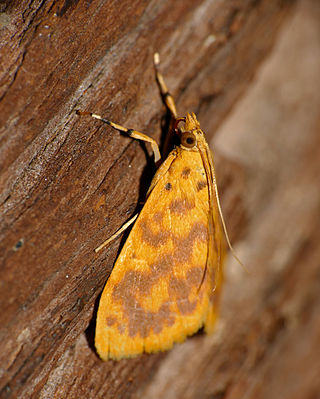
Apatura ilia, the lesser purple emperor, is a species of butterfly native to most of Europe and east across the Palearctic. It is named for its similarity to the purple emperor butterfly.

Cataclysta lemnata, the small china-mark, is a moth species of the family Crambidae. It is found in Europe, Morocco and Iran.

Katha depressa, the buff footman, is a moth of the family Erebidae found in Asia and Europe. It was first described by Eugenius Johann Christoph Esper in 1787.
Charitoprepes is a genus of moths of the family Crambidae. It is placed in the species-rich tribe Margaroniini in the subfamily Spilomelinae.

Niphopyralis is a genus of snout moths of the subfamily Spilomelinae in the family Crambidae.

Euchromius ocellea, the necklace veneer or belted grass-veneer, is a cosmopolitan migratory species of moth of the family Crambidae, first described by Adrian Hardy Haworth in 1811. It has Hodges number 5454.

Mesotype didymata, the twin-spot carpet, is a moth of the family Geometridae. The species was first described by Carl Linnaeus in his 1758 10th edition of Systema Naturae. Its genus is sometimes included in Perizoma.

Acraea anacreon, the (large) orange acraea, is a butterfly of the family Nymphalidae. It is found in Kwazulu-Natal and Transvaal and from Angola to Zimbabwe and to Kenya. Elsewhere in Africa and adjacent regions, "orange acraea" refers to the smaller A. eponina.

Acraea esebria, the dusky acraea, is a butterfly of the family Nymphalidae from southern and eastern Africa.

Colias lesbia is a species of butterfly in the family Pieridae. It is found in the Neotropical realm.
Neomusotima conspurcatalis is a moth in the family Crambidae. It was described by William Warren in 1896. It is found in India, Indonesia, East Timor and Australia.
Sinibotys butleri is a snout moth in the subfamily Pyraustinae in the family Crambidae. It was described in the genus Crocidophora by Richard South in 1901 based on a single female imago collected in Ningbo in China's Zhejiang province. The species is sexually dimorphic, with females exhibiting shorter, less pointed forewings than the males. The imagines and genitalia of the species are illustrated in Lee et al. (2018).
Archernis lugens is a moth in the family Crambidae. It was described by William Warren in 1896. It is found in India.
Prophantis triplagalis is a moth in the family Crambidae. It was described by William Warren in 1896. It is found in India, where it has been recorded from the Khasia Hills.
Rehimena monomma is a moth in the family Crambidae. It was described by William Warren in 1896. It is found in the Khasi Hills of India.
Syllepte paucistrialis is a moth in the family Crambidae. It was described by William Warren in 1896. It is found in India (Meghalaya).
Syllepte seminigralis is a moth in the family Crambidae. It was described by William Warren in 1896. It is found in Meghalaya, India.
Tylostega valvata is a moth in the family Crambidae. It was described by William Warren in 1896. It is found in the Khasi Hills of India.
Cheverella is a monotypic genus of snout moths in the subfamily Spilomelinae of the family Crambidae. It contains only one species, Cheverella galapagensis, which is endemic to the Galápagos Islands of Ecuador. Both the genus and the species were first described by Bernard Landry in 2011. The genus is placed in the tribe Udeini.

Portentomorphini is a tribe of the subfamily Pyraustinae in the pyraloid moth family Crambidae. The tribe was initially erected by Hans Georg Amsel in 1956.









